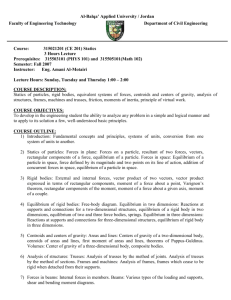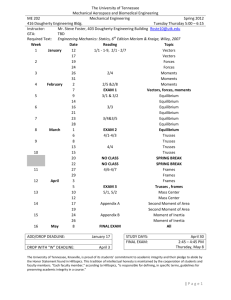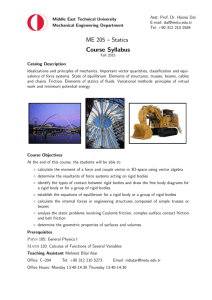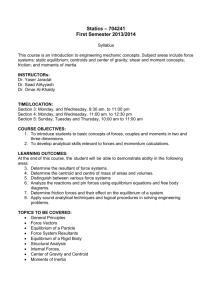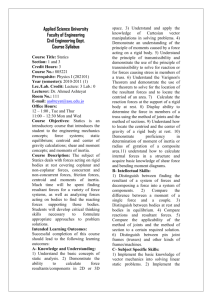HIBBING COMMUNITY COLLEGE COURSE OUTLINE COURSE
advertisement
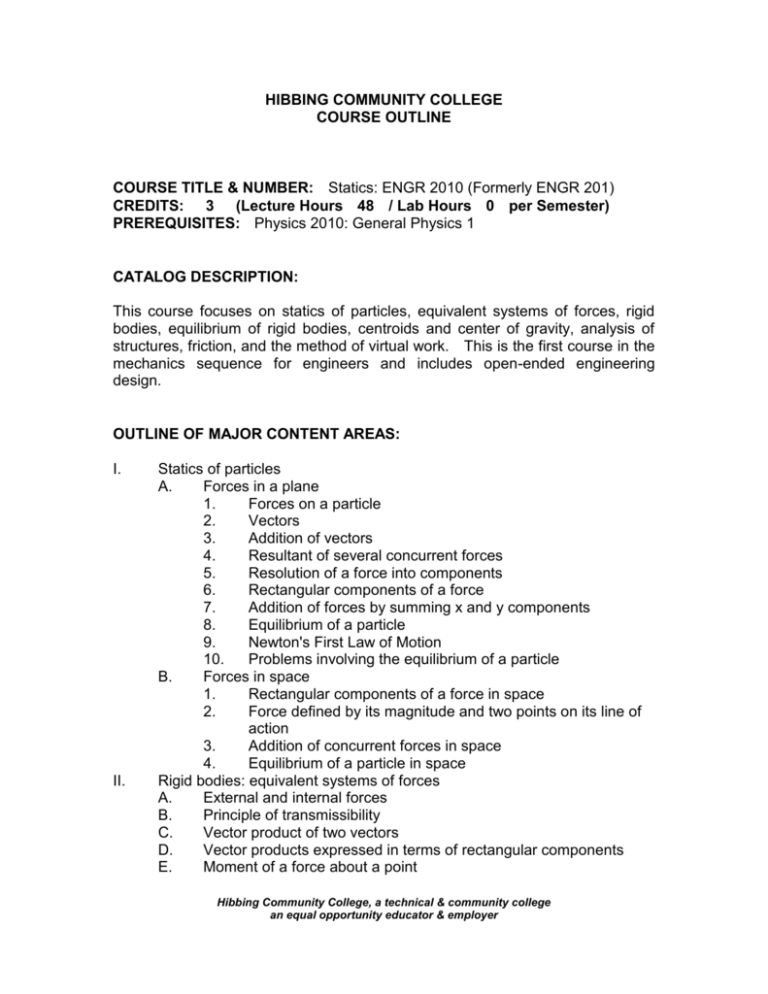
HIBBING COMMUNITY COLLEGE COURSE OUTLINE COURSE TITLE & NUMBER: Statics: ENGR 2010 (Formerly ENGR 201) CREDITS: 3 (Lecture Hours 48 / Lab Hours 0 per Semester) PREREQUISITES: Physics 2010: General Physics 1 CATALOG DESCRIPTION: This course focuses on statics of particles, equivalent systems of forces, rigid bodies, equilibrium of rigid bodies, centroids and center of gravity, analysis of structures, friction, and the method of virtual work. This is the first course in the mechanics sequence for engineers and includes open-ended engineering design. OUTLINE OF MAJOR CONTENT AREAS: I. II. Statics of particles A. Forces in a plane 1. Forces on a particle 2. Vectors 3. Addition of vectors 4. Resultant of several concurrent forces 5. Resolution of a force into components 6. Rectangular components of a force 7. Addition of forces by summing x and y components 8. Equilibrium of a particle 9. Newton's First Law of Motion 10. Problems involving the equilibrium of a particle B. Forces in space 1. Rectangular components of a force in space 2. Force defined by its magnitude and two points on its line of action 3. Addition of concurrent forces in space 4. Equilibrium of a particle in space Rigid bodies: equivalent systems of forces A. External and internal forces B. Principle of transmissibility C. Vector product of two vectors D. Vector products expressed in terms of rectangular components E. Moment of a force about a point Hibbing Community College, a technical & community college an equal opportunity educator & employer III. IV. V. F. Varignon's Theorem G. Rectangular components of the moment of a force H. Scalar product of two vectors I. Mixed triple product of three vectors J. Moment of a force about a given axis K. Moment of a couple L. Equivalent couples M. Addition of couples N. Couples represented by vectors O. Resolution of a given force into a force at O and a couple P. Reduction of a system of forces to one force and one couple Q. Equivalent systems of forces R. Equivalent systems of vectors S. Further reduction of a system of forces Equilibrium of rigid bodies A. Equilibrium in two dimensions 1. Reactions at supports and connections for a twodimensional structure 2. Equilibrium of a rigid body in two dimensions 3. Statically indeterminate reactions 4. Equilibrium of a two-force body 5. Equilibrium of a three-force body B. Equilibrium in three dimensions 1. Equilibrium of a rigid body in three dimensions 2. Reactions at supports and connections Distributed forces: centroids and centers of gravity A. Areas and lines 1. Center of gravity of a two-dimensional body 2. Centroids of areas and lines 3. First moments of areas and lines 4. Composite plates and wires 5. Determination of centroids by integration 6. Theorems of Pappus-Guldinus B. Volumes 1. Center of gravity of a three-dimensional body 2. Composite bodies 3. Determination of centroids of volumes by integration Analysis of structures A. Trusses 1. Definition of a truss 2. Simple trusses 3. Analysis of trusses by the method of joints 4. Analysis of trusses by the method of sections B. Frames and machines Hibbing Community College, a technical & community college an equal opportunity educator & employer 1. 2. 3. VI. VII. Structures containing multiforce members Analysis of a frame Frames which cease to be rigid when detached from their support Machines 4. Friction A. The laws of dry friction B. Angles of friction C. Problems involving dry friction D. Wedges E. Square-threaded screws Distributed forces: moments of inertia A. Moments of inertia of areas 1. Second moment, or moment of inertia, of an area 2. Determination of the moment of inertia of an area by integration 3. Polar moment of inertia 4. Radius of gyration of an area 5. Parallel-axis theorem 6. Moments of inertia of composite area B. Moments of inertia of masses 1. Moment of inertia of a mass 2. Parallel-axis theorem 3. Moments of inertia of thin plates 4. Determination of the moment of inertia of a three-dimensional body by integration 5. Moments of inertia of composite bodies COURSE GOALS/OBJECTIVES/OUTCOMES: The student will 1. analyze forces in two and three dimensions. 2. draw free body diagrams for solution of analysis problems. 3. perform vector mathematical operations. 4. utilize the equations of equilibrium to analyze rigid bodies. 5. calculate centroids and centers of gravity. 6. use the method of joints and the method of sections to analyze simple trusses. 7. calculate moments of inertia of areas and masses. 8. complete an extensive capstone design project in a team environment and submit a professional report. 9. communicate all written work in a professional manner utilizing spreadsheets and word processing applications. Hibbing Community College, a technical & community college an equal opportunity educator & employer HCC COMPETENCIES MET: STUDENT CONTRIBUTIONS: The student will attend class regularly, participate in class discussion, complete assignments, team laboratory or design projects, and take a comprehensive final examination. The student will spend sufficient time to complete all assignments. For disability accommodations, please contact either Barb Anderson (Student Services, North campus, 218-262-6775) or Donna Stuntebeck (Resource Center, Central campus, 218-262-7246) Students are encouraged to discuss their individual needs with the instructor. METHODS FOR EVALUATING STUDENT LEARNING: The final grade is determined by grades earned on homework problems, periodic examinations, a comprehensive design project, and a comprehensive final examination. SPECIAL INFORMATION: (SPECIAL FEES, DIRECTIVES ON HAZARDOUS MATERIALS, TEXTBOOK USED, ETC.) All homework must be done on engineer's paper. A scientific calculator with exponential and logarithmic capabilities is required for this course. ___________________________ Date Approved Hibbing Community College, a technical & community college an equal opportunity educator & employer
